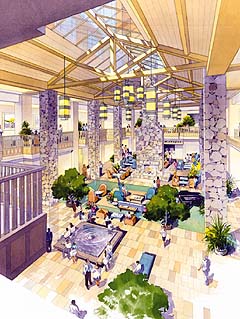
Surveys
AIA Awards
DJC.COM
November 20, 2003
In hospitals, spending more can save money
Anshen+Allen

Images courtesy of Anshen+Allen
Having views from all patient rooms is one of the evidence-based design features planned for Sacred Heart Medical Center’s replacement campus in Eugene, Ore.
|
“We shape our buildings; thereafter they shape us,” observed Winston Churchill. Whatever the purpose — education, healing, worship, business — the space in which we live, work, play and heal can be life supporting or stress producing.
Architects passionately believe in the power of spaces to influence the people who occupy them. In 1984, Dr. Roger Ulrich's study of patients recovering from gallbladder surgery found that those with views of trees from their hospital windows experienced better outcomes than those looking at brick walls. In fact, those looking at nature went home almost a day earlier, had $550 lower costs-per-case, used fewer heavy medications, had fewer minor complications such as nausea, and showed better emotional well-being.
Ulrich's research gave designers of healthcare facilities a basis to argue persuasively in favor of creating medical environments designed to support healing. With the advent of evidence-based design, they have gone one step further in making their case. Using the results of research conducted at healthcare institutions around the country, evidence-based design is now beginning to show that design choices can make measurable differences in patients' return to health.
In addition to improved medical outcomes, evidence-based design has the potential to save hospitals money. As the discipline matures, this growing body of knowledge continues to offer demonstrable evidence to support the claim that improving healthcare facilities' physical environments will produce better medical outcomes and have a positive influence on the bottom line.
What is it?
Like evidence-based medicine, evidence-based design is research-informed. Its results measure not just patient outcomes but also staff satisfaction and facility operations. The emerging science of evidence-based design offers a strong rationale for spending more per square foot on features such as single-occupancy rooms, larger in-room windows with views of nature, comfortable accommodations for families in patient rooms and waiting areas, energy-saving environmental management systems and amenities such as art, sculpture and healing gardens.
Leading much of the research into evidence-based design is the Center for Health Design, a non-profit organization based in California which initiated the Pebble Project in the late 1990s. Like ripples in a pond, today 18 Pebble Projects across the country are gathering outcome-related data before and after construction of new healthcare facilities.
Taking direction from these studies, Anshen+Allen with hospitality architect Wimberly Allison Tong & Goo are creating the hospital of the future in a new replacement campus for Sacred Heart Medical Center in Eugene, Ore., owned and operated by Bellevue-based PeaceHealth.
Expected to break ground in 2004 and open in 2007, the 1 million-square-foot campus is planned as a positive and uplifting environment to promote wellness and reduced stress for patients, their loved ones and hospital staff. The facility will have exterior views in every patient room and use many other warm and inviting features for family members and hospital staff, including trails, gardens, fireplaces, water features, an atrium with grand piano and a comfortable coffee shop.
The design team at Sacred Heart is translating research results into an evidence-based design that improves quality and safety in a way that is environmentally sustainable while creating a welcoming environment.
Results from these studies are showing that healing designs in medical facilities can improve quality of patient care, recruit and retain staff, attract patients and increase patient satisfaction, and enhance operational efficiency and productivity. All of these factors support organizations' missions, and margins.
Benefits

Sacred Heart’s interior design emphasizes residential over institutional.
|
Pebble Project research is designed to discover and share the best-demonstrated practices in healthcare facility design. Pebble Project partners are showing that facility design can impact the delivery, experience and cost of healthcare. It can:
- Reduce patient falls by providing space for caregiver assistance in bathrooms. Patient falls are a significant and costly problem in hospitals that also increases length of stay.
- Reduce patient transfers to minimize disruption of patients and the possibility of medical errors. Patients can be moved as much as six times during a typical visit. Every move increases the risk of error by 75 percent. Larger, single patient rooms designed to accommodate varying degrees of acuity reduce the need for transfers.
- Reduce hospital-based infection through single patient rooms, high-quality air filtering and convenient hand-washing stations. The total financial cost of hospital-based infections is estimated at $4.5 billion per year.
- Reduce employee turnover. Address the nursing shortage by designing floor layouts that save steps for staff members. Pleasant environments appeal not just to patients, they can improve staff morale, recruitment and retention.
- Reduce costs by considering efficiencies in design and decreasing variable costs.
- Reduce medical errors, especially medications, by improving lighting, noise reduction and work space for staff.
- Reduce need for pain medications. Improvement in environmental quality has been shown to reduce patients' self-administered pain medication by up to 16 percent. This is both better care and less costly.
- Reduce length of stay. Patients in pleasant, stress-free environments go home sooner. Caregivers know that most patients do better at home if support is available. Shorter stays means hospital resources are available to more patients — both good business and good healthcare.
- Increase market share and competitiveness through improved patient, family and staff satisfaction. Healthcare providers now compete for patients' healthcare dollars.
- Increase philanthropy through improved design and a well-articulated, compelling vision. Good design encourages donors.
When these factors are taken into account, a hospital design can produce better clinical outcomes for patients — the primary goal of healthcare facilities — and also make sense to those making the financial decisions.
The business case
The marketplace is constantly changing. Today, healthcare facilities are addressing issues such as increased demands of an aging population, baby boomers' higher expectations and demands upon services, the need for flexible facilities to accommodate rapidly changing technologies, increased competition for patients, the ongoing need for operational efficiency, and staff recruitment and retention.
The improvements advocated by proponents of evidence-based design sound promising, but how do hospitals already struggling with low margins justify the cost? Anshen+Allen's Derek Parker believes that the business case for healing design has become less anecdotal and more quantitative.
“We're making the case that a very slight increase in capital spending to build healing facility designs — on the order of only 5 percent — provides a return on investment in under a year,” says Parker. “The average cost of an non-litigated patient fall is $10,000. If organizations can reduce patient falls through facility design, that savings drops right to the bottom line.”
Evidence-based design promises to assist healthcare facilities in meeting the demands of the industry today and in the future. It points the way to sound, documented solutions to some of the industry's most pressing problems.
Adam Kerner, AIA, ACHA, is managing principal of the Seattle office of Anshen+Allen, an architecture firm specializing in healthcare and academic facility design.
Other Stories:
- Today's buildings load up on technology
- Letting rainwater reign in the design process
- Church praises the benefits of adaptive re-use
- UW builds on design leadership training
- Science studies how architecture affects the brain
- China creates a park with environmental appeal
- How the Great Fire changed Seattle's architecture
- Architects play catch-up in the business world
- Designing with nature in the balance
- 12 keys to creating authentic people places
- Monorail to move urban design as well as people
- Water tower repairs borrow on building technology
- Technology takes center stage in performance halls
- Don't be violated — protect plans with copyrights
- Special dampers may shake up engineering field
- UW Allen Center fosters a culture of research
- Here's why projects need to be commissioned
- Unwrapping modern building envelopes
- Lessons on sustainability, Scandinavian style
- Building a highrise on the fault line
- How to keep development from killing trees
- Rx for changing healthcare industry: Good design
- Muckleshoot project blends culture with design
Copyright ©2009 Seattle Daily Journal and DJC.COM.
Comments? Questions? Contact us.